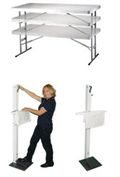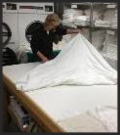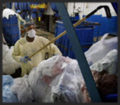Laundry Risk Factors and Best Practices -Part III
Responsibilities of commercial laundry staff can include washing, drying, steaming, ironing, and chemically treating fabrics for use in hospitals, hotels, and other settings. Laundry can be heavy, treated with chemicals, and the work environment can be hot and humid.Work area set up, proper tools, staff training, machine maintenance, and good body mechanics are essential for laundry staff safety.
This 3 part blog summarizes the general hazards and controls for three major activities or tools in commercial laundry operations.
- Part I: Bins, Bags and Carts
- Part II: Washing and Drying
- Part III: Sorting and Folding
If you are looking for more detail on industrial laundry safety, check MEMIC’s recorded Hotel Safety Webinar on MEMIC's Safety Director.
Activity or Tool: Sorting and Folding
Sorting and folding in commercial laundry operations, if not managed properly, creates risk factors for the worker. The size, weight and volume of the linen processed can be challenging for the worker to manage. Add the repetitious nature of the movements necessary to process the linen and it becomes apparent why sorting and folding can be tough work.
1) Risk Factors:
a) Awkward postures
i) shoulder, trunk, upper body, wrist and elbow postures

b) Repetitive motions
i) Grasping, lifting, reaching, bending
c) Excessive force
i) Lifting heavy bedding and oversized linen
d) Prolonged standing at folding stations
e) Chemical and BBP exposure
2) Controls:
a) Engineer the Space
i) Place anti fatigue mats at each work station
ii) Use adjustable tables to accommodate different worker heights
(1) Tables should be adjusted to just below elbow height for folding

(2) If tables cannot be adjusted, raise tables to fit the average taller worker and provide a removable safe work platform for shorter workers
iii) Use folding arms to support laundry as it’s being folded
iv) Install automated folding machines for small items
b) Administrative Controls
i) Rotate job tasks to decrease repetition
(1) Workers should be trained and rotated through all tasks in the laundry space to minimize excessive repetitions of the same motion
ii) Power grip rather than pinch grip while picking up laundry
(1) Using a power grip rather than the pinch grip can reduce the necessary force it takes to handle the laundry.
iii) Awkward posture avoidance: 
(1) Avoid holding laundry up high with your arms
(a) Keep elbows low or by your side.
(2) When folding large pieces,
(a) Keep arms low and use a clean bin or table to support the piece
(b) Practice team folding
c) Policies and Procedures

i) Develop policies and procedure that ban sorting and moving laundry at floor level.
ii) Ensure procedures are in place to minimize all lifting below knee level; place all laundry in containers and bags, or use a laundry hook.
d) Mechanical Assistance
i) Laundry should be moved within the facility in bins or carts, never in bundles or bags by hand.
ii) Tilt tables or tilting carts can assist with loading washers and dryers, and getting dry laundry onto the folding tables without excessive bending or reaching.
iii) Use laundry hooks or rakes to get laundry from the far back of the washer/dryer, sorting table, or bottom of the bin.
e) Chemical and Pathogen Safety
i) Use of latex or nitrile gloves, aprons and safety glasses can help prevent contact with harsh chemicals and bloodborne pathogens if present.
ii) Read, understand, and know the location of the Safety Data Sheets (SDS - formerly MSDS) for the chemicals you will be working with and around.

